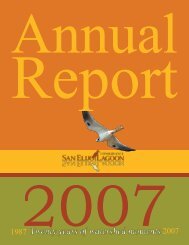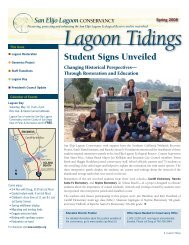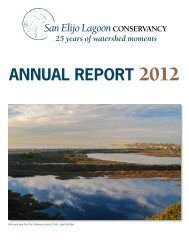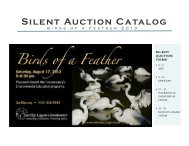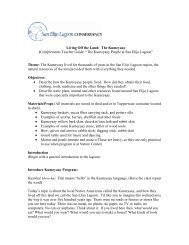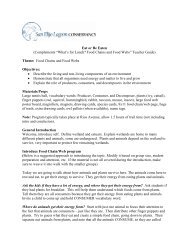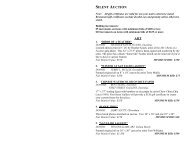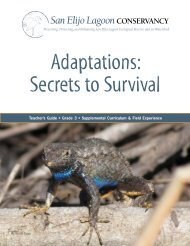Dogs Cats Guide - San Elijo Lagoon Conservancy
Dogs Cats Guide - San Elijo Lagoon Conservancy
Dogs Cats Guide - San Elijo Lagoon Conservancy
You also want an ePaper? Increase the reach of your titles
YUMPU automatically turns print PDFs into web optimized ePapers that Google loves.
Germs and Parasites<br />
We hate to bring this up, but we know the topic holds a<br />
compelling fascination for many dogs on the trails at<br />
<strong>San</strong> <strong>Elijo</strong>. When dogs visit the reserve, they inevitably<br />
feel the need to heed nature’s call. But left in place,<br />
those “calling cards” become biological time bombs,<br />
just waiting to unleash their virulent pathogens on<br />
unsuspecting dogs that can’t resist stopping to check out<br />
the message. This is how some serious bacterial<br />
infections get transmitted, as well as several different<br />
types of intestinal parasites. This doesn’t just affect<br />
dogs. Other wildlife is also endangered by the germs<br />
and parasites contained in dog droppings.<br />
It doesn’t stop there. Other dogs and people sometimes<br />
step in fresh dog droppings and then track the filth into<br />
their cars and homes.<br />
Dog droppings along the trail contribute to excessive<br />
bacteria that upset the natural ecology. It pollutes the<br />
water of the lagoon and ocean, and increases the<br />
incidence of beach closures by the County Health<br />
Department.<br />
Of course, dog droppings along the trail have a very<br />
negative aesthetic impact on others attempting to enjoy<br />
a walk or jog in the reserve.<br />
Don’t be a party pooper – have your<br />
droppings picked up and properly<br />
disposed of.<br />
<strong>San</strong> <strong>Elijo</strong> <strong>Lagoon</strong><br />
Ecological Reserve<br />
has been set aside as a refuge for native plants<br />
and animals that once spread freely over our<br />
hills, canyons, and marshes. Please help keep<br />
it clean, safe, and healthy for all wildlife<br />
including you.<br />
<strong>Dogs</strong> and <strong>Cats</strong> in the<br />
Reserve<br />
Rules, Regulations, and Common<br />
Courtesy<br />
<strong>Dogs</strong> must be kept on a leash at all<br />
times. No free-roaming dogs allowed.<br />
Protects dogs from off-trail dangers<br />
Protects other trail users<br />
Avoids potential injuries and lawsuits<br />
Protects native animals from being harmed<br />
Protects native plants from being trampled<br />
Avoids a citation for breaking a county parks regulation<br />
Pick up after your dog and properly<br />
dispose of the waste.<br />
Prevents the transmission of diseases and parasites<br />
Protects others from stepping in your dog’s droppings<br />
Protects the habitat from high levels of bacteria<br />
Improves water quality in lagoon and ocean<br />
Enhances the aesthetic value to all users<br />
Keep cats inside or in your yard.<br />
They are NOT a natural part of the<br />
reserve’s ecosystem<br />
Doubles the average life expectancy of your cat.<br />
Provided by<br />
<strong>San</strong> <strong>Elijo</strong> <strong>Lagoon</strong> <strong>Conservancy</strong><br />
www.sanelijo.org | 760.436.3944<br />
<strong>Dogs</strong> and <strong>Cats</strong><br />
at<br />
<strong>San</strong> <strong>Elijo</strong> <strong>Lagoon</strong><br />
Many dogs and cats enjoy visiting the wonderful natural open<br />
space of the <strong>San</strong> <strong>Elijo</strong> <strong>Lagoon</strong>.<br />
What’s not to love? After a week of loafing around the house,<br />
a trip to the lagoon promises a lot of excitement.<br />
<strong>Dogs</strong> especially seem to enjoy the intriguing scents wafting<br />
over the chaparral-covered hillsides. There’s the expectation of<br />
exciting nature discoveries around every turn. And past treks<br />
have always resulted in chance reunions with old trail buddies,<br />
or stimulating encounters with some potential new friends. A<br />
trot along the trail provides the opportunity to rub up against<br />
the sagebrush for an intoxicating infusion of rich earthy smells.<br />
Of course, it’s always fun to leave a mark for later trekkers to<br />
take note of the passage of such a noble beast.<br />
<strong>Cats</strong>, of course, are a little less open about their excursions into<br />
the reserve. They also enjoy the stimulating scents, of course,<br />
but seem particularly moved by the opportunity to test their<br />
primal skills as hunters.<br />
Dangers Lurk<br />
As fun as the prospect of a carefree romp in the reserve might<br />
sound, dogs and cats should be aware that serious threats<br />
abound. A little knowledge of the potential dangers, and some<br />
commonsense precautions to follow, can help avoid serious<br />
injuries and illness.
Rattlesnakes<br />
Lots of western diamondback rattlesnakes live in the reserve.<br />
People see them along the trail occasionally, but generally the<br />
snakes are off trail in the chaparral. <strong>Dogs</strong> probing in the<br />
bushes are bitten by rattlesnakes every year in <strong>San</strong> Diego<br />
County. The results are often very sad. The snakes’ venom<br />
has a greater impact on dogs as opposed to humans, because of<br />
their smaller size. After snakebite, dogs often aren’t able to get<br />
back to knowledgeable and caring humans in time for medical<br />
intervention. Even with timely medical help, a dog’s recovery<br />
from a snakebite is not assured and can be very expensive for<br />
the one paying the bills.<br />
Avoid snakebites by keeping on leash<br />
and staying on marked trails.<br />
Poison Oak<br />
<strong>Dogs</strong> don’t really care about poison oak. It doesn’t seem to<br />
bother them a bit. The problem is that when they brush against<br />
the plant while moving through the underbrush (searching for<br />
more rabbits?), the oily resins get on their fur. Back home they<br />
may rub against or get petted by people sensitive to poison oak<br />
(most of us), and the resins are transferred. Someone then gets<br />
a mysterious and very nasty red rash. The good news is that<br />
poison oak only grows off trail at <strong>San</strong> <strong>Elijo</strong>, so good dogs<br />
NEVER get in trouble by bringing it home on their fur.<br />
Don’t come in contact with poison oak.<br />
Resist the temptation to go off trail<br />
looking for rabbits<br />
Skunks<br />
Cute little black and white striped mammals with bushy black<br />
tails, skunks remind dogs of those next door cats that always<br />
stay maddingly out-of-reach. Of course they’re going to chase<br />
them if they get the chance… Bad idea. How many people<br />
have ever had to drive home with their dog after it had an<br />
encounter with a cute little skunk?<br />
Milk or tomato baths are embarrassing<br />
for a strong husky dog like you. Stay on<br />
your leash and avoid temptations.<br />
Ticks<br />
Ticks may be part of the natural order of things in the reserve,<br />
but most dogs and cats would consider them disgusting little<br />
blood-suckers. Ticks are everywhere in the dense chaparral.<br />
They lie in wait at the tips of the bushes for an unsuspecting<br />
host to brush by, and then they hitch a ride and enjoy a meal.<br />
One of the 49 species of ticks found in California transmits<br />
Lyme disease, and several cases have been reported in <strong>San</strong><br />
Diego. All ticks feed by imbedding their mouthparts into the<br />
skin and gorging on the blood of its victim. The sores can<br />
become infected, leading to expensive vet bills.<br />
Avoid ticks by staying on trail and<br />
getting a good brushing and examination<br />
after your walk<br />
Burs and Foxtails<br />
Cocklebur is a shrub that grows along the marsh. Its burs are a<br />
little less than an inch long, shaped like an olive pit, and<br />
covered with tiny hooks. It’s the natural prototype for Velcro.<br />
Cockleburs attach to anything passing by and hitch a ride a<br />
further down the trail. This is how their seeds are dispersed<br />
and the plant expands its range. If a person carefully pulled<br />
out a cocklebur from their socks and tangled it up in their hair,<br />
they’d know what dogs go through all the time. Foxtails are<br />
what we call the seed heads of certain grasses. They break<br />
loose and stick on clothes, or maybe the hair hanging down<br />
around a dog’s long floppy ears. Once in place, a foxtail works<br />
its way forward in one direction. It can’t back up, and people<br />
have to pull it through their clothing to get rid of it. The<br />
problem for dogs is the pointy end can get started working its<br />
way up into the ear or nasal canal or into the soft skin between<br />
the toes. It takes some serious work (often under anesthesia)<br />
by a good vet to extricate a well-entrenched foxtail.<br />
Avoid cockleburs and foxtails by sticking<br />
to the trail. Get checked out after your<br />
walk to remove all offending hitchhikers.<br />
Coyotes<br />
Coyotes eat a lot of things, but they are especially fond of<br />
small and medium sized mammals. Domestic cats have very<br />
little chance to escape a coyote if they’re caught out in the<br />
reserve. Most average-sized dogs could avoid an encounter<br />
with the generally cautious coyote by simply turning away.<br />
But many dogs have not learned that lesson. Depending on<br />
their size, dogs may have a better chance of surviving a fight<br />
with a coyote, but they almost always will emerge with serious<br />
wounds.<br />
Don’t give coyotes a chance to stray from<br />
their recommended diet of mice, rabbits,<br />
and berries. Stay on your leash and in<br />
the company of your two-legged<br />
companion.




